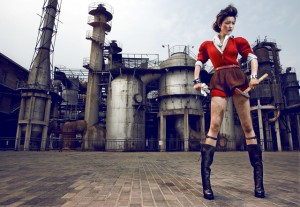
In her work, thirty-five year old photographer and artist Chen Man “acknowledges the position of China within a predominately western fashion system and states a deliberate use of East-West binary…to work from a truly Chinese perspective whilst adopting western technics.”(Radclyffe-Thomas 4) By combining traditional Chinese landscapes and modern photo editing techniques, Man aims to “produce modern representations of China,” that replace hegemonic western stereotypes and orientalism. Chen Man’s working modo is “Chinese Essence, Western Method.” (define immediately the claimed notion) In particular, Man’s collection “Chen Man East-West” occupies both floors of L.A. Louver, a gallery in Venice, California.

Long Live the Motherland, Beijing No 3, 2009
Denotations:
Man’s photograph, Long Live the Motherland, Beijing No 3, is part of this collection. In the foreground, a Chinese women stands off to the right of the frame. Her long legs are smeared with dirt and she wears tall leather boots and a short red romper. On each wrist, she wears metallic cuffs and she holds a hammer and work gloves. Her hair is pulled back and a skinny brown belt runs across runs across her waist securing a small brown work apron. Her rouge and pouting red lips are prominent as she looks off to the right of the frame. In the background of the photo is a large industrial complex. The photo is taken from a low angle.
Connotations:
The photos title (Long live the Motherland) and red elements conjure notions of Chinese nationalism. In a way, the photo acts to replace the depictions of the model Chinese women propagated during the Maoist era. Instead of an androgynous genderless figure, the women’s feminine qualities are proudly on display. Although her accessories (the work gloves, hammer*, and work apron) clearly connote that she is capable of any man’s job, she is not masculinized. Instead, her short romper, tight belt, exposed legs, and tall boots accentuate her sexuality. Her up do is in a state of intentional disarray. Her facial expression is one of subtle determination and immediately brings ‘Rosie the Riveter’ to mind. The model’s strong presence is defined by her firm stance, muddy legs, and proud display of feminism. By placing the model to the right of the frame, the viewer’s glance is drawn by a sense of depth to the back of the photo. The industrial background is a proud display of Chinese manufacturing and economic power. It provides a direct link to modernity and only bolsters the strength of the model in the foreground. In a way, the factory is a traditional chinese background. China’s economic power is inherent to the nation-states national identity. This representation defies typical western orientalist perspective by using modern chinese elements instead of traditional symbolism to connote chinese identity. The low angle of the photo accentuates the women’s legs and gives the viewer a ‘bigger than life’ perspective.
*The hammer also denotes communism: revolution/political motifs and empowered female image: call for further exploration. Does the analysis support the claim of Chinese Essence, Western Method?
Sources: Chan Man would be a wonderful case for further research
Radclyffe-Thomas, Natascha and Radclyffe-Thomas, Babette (2015) The new Shanghai Xiaojie: Chinese fashion identities. International Journal of Fashion Studies, 2 (1). pp. 43-62. ISSN ISSN 2051-7106, Online ISSN: 2051-7114
http://www.chenmaner.com/index.html
http://blogs.kcrw.com/dna/chen-man-high-flying-fashion-photographer-and-poster-child-for-the-post-1980s-chinese#.Vw2A-ixViko
http://www.photographyofchina.com/blog/chen-man
